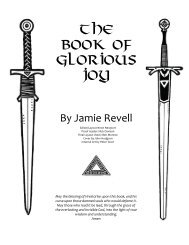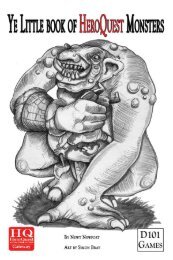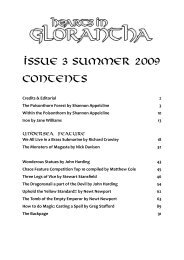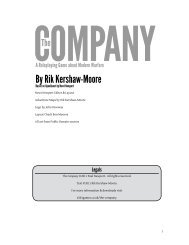HiG Issue 2 preview â Pdf (1.8 MB) - Hearts In Glorantha
HiG Issue 2 preview â Pdf (1.8 MB) - Hearts In Glorantha
HiG Issue 2 preview â Pdf (1.8 MB) - Hearts In Glorantha
Create successful ePaper yourself
Turn your PDF publications into a flip-book with our unique Google optimized e-Paper software.
<strong>Hearts</strong> in <strong>Glorantha</strong> winter 2009<br />
ElfPak Designer<br />
Notes<br />
By Shannon Appelcline<br />
whoserueisitanywa<br />
It began in Dorastor, as all good things do. The year<br />
was 1994 and Avalon Hill had recently published<br />
Dorastor: Land of Doom, the third triumphant<br />
release in Ken Rolston’s RuneQuest Renaissance.<br />
After years of neglect, <strong>Glorantha</strong> was coming back<br />
to life under his able hand.<br />
There were numerous additional books in<br />
preparation or outline by the start of the year, and<br />
my friend Stephen Martin had managed to get right<br />
in the middle of that renaissance. When he was<br />
working on Lords of Terror he asked me to write<br />
up an NPC for him, which I did. (I think it was the<br />
Daughter of Ralzakark.) He also got me onto the<br />
email discussion list of another book, which would<br />
have continued the focus on Dorastor. It was called<br />
Oak and Thorn: Elves of Dorastor.<br />
The Oak and Thorn<br />
Genesis<br />
Though Oak and Thorn was focused on the two<br />
rather strange elf cultures of that ruined land, it<br />
would have offered a pretty good overview of elf<br />
culture in general. It perhaps wouldn’t have been an<br />
ElfPak, but it would have still been the best look at<br />
the elves of <strong>Glorantha</strong> ever. As a result, Rolston was<br />
thinking quite a bit about the elves and what their<br />
culture was really like. Thus, I began to hear word<br />
that there was an “elf secret.”<br />
Today it might seem pretty commonplace, because<br />
it’s been pretty well integrated into both HeroQuest<br />
and everything I’ve ever written about elves, but<br />
back in 1994, it was revelatory. It was a fact about elf<br />
culture that helped to explain the elves’ place in the<br />
universe and what made them unique. It was simply<br />
this: the elves were telepathic.<br />
This was the true explanation of elfsense—that<br />
elves could come to joint agreements for the whole<br />
forest, through thought alone. There were some<br />
details in Rolston’s original writings that haven’t<br />
made it into my own. For example, he called the<br />
group gestalt of elven thought the “Allspirit” and<br />
he also imagined elfsense to be a very intimate<br />
type of communication that depended on touch.<br />
Nevertheless, the core idea that has influenced<br />
everything written about the Aldryami since was<br />
there.<br />
At this point, I’m not quite sure how I became<br />
a writer about elves, but sometime after I was<br />
introduced to the Oak and Thorn discussion, I<br />
offered to write up an elven mythos. Mythology was<br />
one of my first loves and what got me interested<br />
in <strong>Glorantha</strong> in the first place. Remarkably, Greg<br />
Stafford, Ken Rolston, and the others were<br />
interested in hearing my ideas. So, in 1994 I wrote<br />
up my first draft of elven mythology, for potential<br />
inclusion in Oak and Thorn.<br />
Looking back now at what I wrote then, I’m<br />
surprised by how much it’s stayed the same. I<br />
imagined a very regularized and animistic mythology<br />
where the earliest gods broke apart to form the<br />
parts of the world. It’s the clear skeleton of what’s<br />
eventually seen print, though I notice a few of<br />
the names have changed. At the time, Greg was<br />
already started to de-god-learner-ize the mythology<br />
of <strong>Glorantha</strong>, and thus where my original writings<br />
simply used the names of existing gods, like Yelmalio<br />
and Triolina, what would finally see print used elven<br />
names for deities, like Halamalao and Eron.<br />
Of course we now know that early writing was<br />
largely in vain, because the RuneQuest Renaissance<br />
was doomed. Ken Rolston was soon to leave Avalon<br />
Hill due to the insufficient support coming from<br />
management and Oak and Thorn was never to see<br />
print. It’s a pity; there were some great ideas there.<br />
Even though the societal ideas for the elves have<br />
emerged and taken what I hope is a final form in<br />
my two books on the Aldryami, the details on the<br />
Hellwood and Poisonthorn elves are still deserving<br />
of publication on their own.<br />
Creating a<br />
Mythology<br />
<strong>In</strong> the years that followed, RuneQuest floundered,<br />
and thus there didn’t seem to be much reason to put<br />
a lot of effort into <strong>Glorantha</strong>n writing. I worked at<br />
Chaosium from 1996-1998, and I know I still talked<br />
about elves a few times with Greg. I even revised my<br />
short mythology in 1997. However, not much more<br />
got done. One thing did come out of this time: Greg<br />
and Stephen both came to think of me as the elf<br />
guy. Ken Rolston really properly should have written<br />
the book on elves, but he was gone from the hobby<br />
by this time, so it fell on me instead. became<br />
25




![The Company-preview Aug 2010 â Pdf [1Mb] - D101 Games](https://img.yumpu.com/41633347/1/184x260/the-company-preview-aug-2010-a-pdf-1mb-d101-games.jpg?quality=85)


